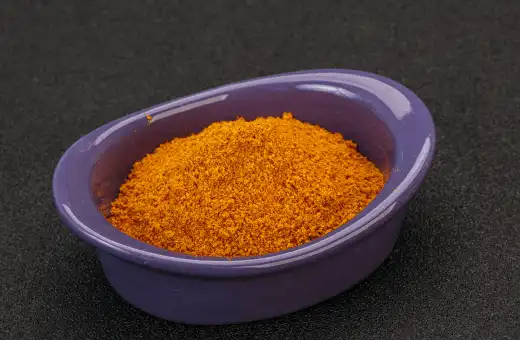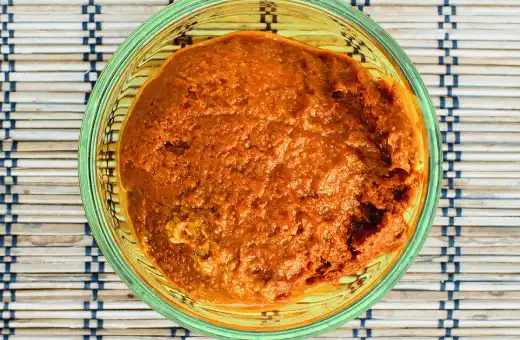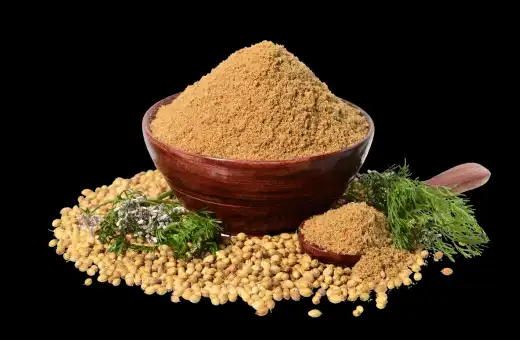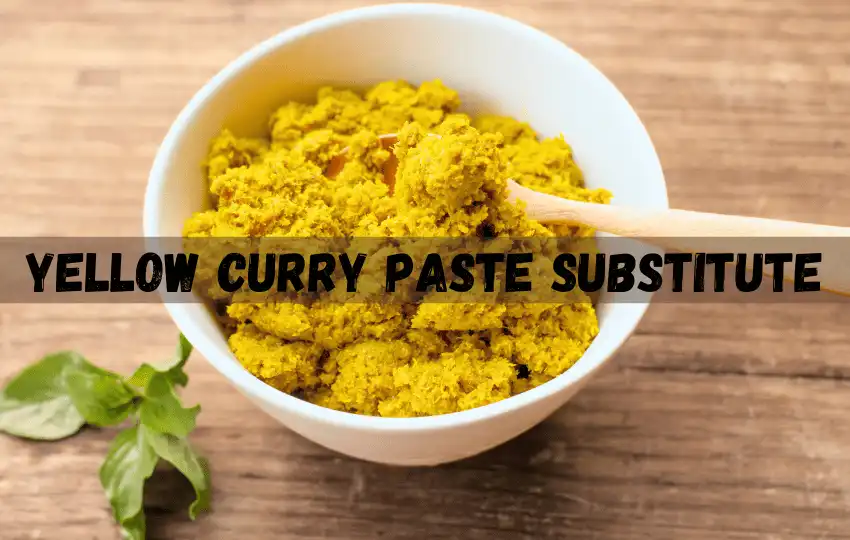One of the most ordinary ingredients in Thai cuisine, yellow curry paste, is a vibrant, flavorful paste that adds an exotic, delicious kick to any dish.
But sometimes, finding or even making yellow curry paste can be difficult.
So what do you do when you’re making a curry dish and you’re out of yellow curry paste? Don’t worry!
There are many ideal yellow curry paste substitutes that you can use.
In this post, we’ll explore the 9 best yellow curry paste substitutes with ratios to help you create an authentic Thai curry dish.
In short, " What can I use instead of yellow curry paste?" Curry Powder, Turmeric, Red Curry Paste, Garam Masala, Indian Curry Powder, Tom Yum Paste, Masaman Curry paste, Green Curry Paste, Coriander.
What is yellow curry paste, and what does yellow curry paste taste like?
Yellow curry paste is a key ingredient in Thai cuisine and is used to create aromatic and flavorful yellow curries. This is a mix of different spices and herbs that are ground into a paste-like consistency.
Yellow curry paste typically includes ingredients such as turmeric, coriander, cumin, lemongrass, garlic, shallots, galangal (a type of ginger), shrimp paste, and various chili peppers.
The taste of yellow curry paste is rich, complex, and fragrant. It has a balance of flavors that includes earthy and warm notes from the turmeric and spices, citrusy and herbal undertones from the lemongrass, and a small kick of heat from the chili peppers.
The combination of ingredients creates a harmonious blend of flavors that is both savory and aromatic.
When cooked with coconut milk and other ingredients, yellow curry paste imparts its vibrant flavors into the dish, creating a creamy and flavorful curry with a mild to moderate level of spiciness.
The taste profile of yellow curry paste can vary slightly depending on the brand or homemade recipe, but it generally offers a delightful balance of flavors that is loved for its depth and complexity.
yellow curry paste ingredients
The specific ingredients used in yellow curry paste may vary just depending on the brand or recipe, but here are the common ingredients found in yellow curry paste:
1. Turmeric: This vibrant yellow spice is the main ingredient that gives yellow curry paste its distinct color and flavor.
2. Coriander: Ground coriander seeds contribute a citrusy and slightly sweet flavor to the paste.
3. Cumin: Ground cumin seeds and add a warm and earthy note to the curry paste.
4. Lemongrass: The tender part of lemongrass stalks provides a citrusy and herbal flavor that is characteristic of Thai cuisine.
5. Garlic: Freshly minced or powdered garlic adds depth and pungency to the paste.
6. Shallots: Finely chopped or powdered shallots offer a mellow and sweet onion-like flavor.
7. Galangal: Galangal, a root similar to ginger, provides a unique and slightly spicy flavor profile.
8. Shrimp paste: This fermented paste made from ground shrimp adds a savory and umami element to the curry paste. However, vegetarian or vegan versions of yellow curry paste may omit this ingredient.
9. Chili peppers: Various types of chili peppers, such as Thai bird’s eye chili or dried red chili peppers, are used to add heat and spiciness. The amount of chili peppers can be adjusted based on personal preference.
Additional optional ingredients may include kaffir lime zest, white pepper, salt, and other aromatic herbs and spices.
These ingredients are typically blended or ground together to create a smooth or slightly textured paste that is used as a base for yellow curry dishes.
Uses of yellow curry paste
For a unique flavor, yellow curry paste can also use as a rub or marinade for meats such as chicken and beef. This also can be added to soups and stews to give them an extra kick of spicy flavor.
When combined with coconut milk, it can be used to make creamy curries filled with vegetables and protein-rich ingredients such as lentils or shrimp.
Yellow curry paste also makes an excellent accompaniment for rice or noodle dishes like pad Thai. It brings out subtleties in the dish that are often overlooked when using other ingredients alone.
Blending it with vegetables like squash or eggplant may result in a delicious side dish that will stand out on any table setting.
The health benefits of yellow curry paste are numerous due to its increased concentration of antioxidants from the various spices used in its making.
Turmeric is an especially powerful antioxidant that has been linked to disease prevention and improved heart health, while cumin provides digestive aid, and cinnamon helps regulate blood sugar levels.
Where to buy yellow curry paste?
If you are looking for yellow curry paste where to buy, there are a few other places you can go. Many specialty food stores carry it, as do some international grocery stores.
You can also order online from many retailers that provide a variety of diverse flavors and types of yellow curry paste.
Delicious yellow curry paste substitutes with a perfect ratio
1. Curry Powder – An ideal Yellow Curry Paste Substitute

Curry powder is the most common substitute for yellow curry paste. It blends different spices, including turmeric, cumin, coriander, and chili powder.
Ratio or measurement: The ratio of curry powder to yellow curry paste is one tablespoon of curry powder to one teaspoon of yellow curry paste.
2. Turmeric – A great Yellow Curry Paste alternative
Turmeric is another great substitute for yellow curry paste because it gives the dish a vibrant yellow color and a subtle earthy flavor.
Turmeric has a slightly bitter taste, which can be offset with other spices.
Ratio or measurement: The ratio of turmeric to yellow curry paste is one tablespoon of turmeric to one teaspoon of yellow curry paste.
3. Try Red Curry Paste to replace Yellow Curry Paste

One of the easiest and most accessible substitutes for yellow curry paste is red curry paste, which is widely obtainable in most grocery stores.
Red curry paste is slightly spicier than yellow curry paste and also has a more prominent flavor.
Ratio or measurement: To use it as a replacement, use about 1 tablespoon of red curry paste for every tablespoon of yellow curry paste required.
4. Garam Masala – A good Yellow Curry Paste Substitute
Garam masala is a mix of various spices used mainly in Indian cuisine. It contains cinnamon, cloves, cardamom, cumin, and coriander.
It adds a warm, earthy flavor to dishes and works well as a substitute for yellow curry paste.
Ratio or measurement: The ratio of garam masala to yellow curry paste is one tablespoon of garam masala to one teaspoon of yellow curry paste.
5. Use Indian Curry Powder instead of Yellow Curry Paste

Indian curry powder is a mix of spices similar to curry powder but with a more complex flavor. It contains turmeric, cumin, coriander, cardamom, and other spices.
Ratio or measurement: The ratio of Indian curry powder to yellow curry paste is one tablespoon of Indian curry powder to one teaspoon of yellow curry paste.
6. Tom Yum Paste – similar to Yellow Curry Paste
Tom Yum Paste is a Thai spicy, sour paste with a strong lemongrass flavor and aroma. It’s a great substitute for yellow curry paste if you enjoy spicy food.
Ratio or measurement: The ratio of Tom Yum Paste to Yellow Curry Paste is one tablespoon of Tom Yum Paste to one teaspoon of Yellow Curry Paste.
7. Masaman Curry paste – A great Yellow Curry Paste replacement

Masaman Curry is another great substitute for Yellow Curry Paste. It’s a unique Thai Curry that has a slightly sweet flavor profile due to the use of coconut milk and roasted peanuts.
Its spice levels are mild, making it a perfect substitute for Yellow Curry Paste.
Ratio or measurement: The ratio of Masaman Curry to Yellow Curry Paste is one tablespoon of Masaman Curry to one teaspoon of Yellow Curry Paste.
8. Try Green Curry Paste to alter the taste of Yellow Curry Paste
Green curry paste is another ideal alternative to yellow curry paste that has a milder flavor. It’s made with fresh herbs and spices, and it’s slightly spicier than yellow curry paste.
Ratio or measurement: To use green curry paste as a replacement, use about 1 tablespoon of green curry paste for every tablespoon of yellow curry paste required.
9. Coriander – a good Yellow Curry Paste

Coriander seeds or ground coriander can also be used as a substitution for yellow curry paste. Coriander has a warm, sweet, and slightly citrusy flavor that complements Thai dishes.
Ratio or measurement: To use coriander as a replacement for yellow curry paste, use about 1 teaspoon of coriander seeds or ground coriander for every tablespoon of yellow curry paste required.
Yellow curry paste ingredient replacements
While yellow curry paste has a unique flavor profile, if you don’t have access to it or prefer to make a homemade alternative, you can use the following ingredient replacements:
1. Turmeric
Turmeric is the key ingredient that gives yellow curry its distinct color. If you don’t have turmeric, you can use curry powder, which already contains turmeric, along with other spices.
Adjust the quantity based on your taste preferences.
2. Coriander and cumin
If you don’t have coriander or cumin seeds, you can use ground coriander and cumin powder instead. Use equal amounts of each to replace the seeds in the recipe.
3. Lemongrass
Lemongrass contributes a citrusy and herbal flavor. If you can’t find fresh lemongrass, use lemongrass paste or lemongrass powder as a substitute.
Alternatively, add a small amount of lime zest and juice for a hint of citrusy flavor.
4. Garlic and shallots
If you don’t have fresh garlic or shallots, also you can use garlic powder and onion powder as replacements. Use about 1/2 teaspoon of each powder per clove or shallot.
5. Galangal
Galangal has a distinct flavor, but if you can’t find it, also you can use ginger as a substitute. While the taste won’t be exactly the same, ginger will provide a similar aromatic and slightly spicy note.
6. Shrimp paste
If you choose a vegetarian or vegan alternative, you can omit shrimp paste from the recipe.
To compensate for the umami flavor, you can add a little amount of soy sauce or tamari for depth.
Find More- Yellow Curry Paste Vs. Red Curry Paste
yellow curry recipe without paste
Yellow curry is a traditional Thai dish that can be made without curry paste.
The principal ingredients used in this recipe are coconut milk, yellow curry powder, onion, garlic, ginger and chicken (or other meat/vegetables/tofu of your choice).
To make the dish:
- Begin by sautéing the garlic and onion in a large pan until softened.
- Add the ginger and resume to cook for a few more minutes.
- Add your chosen meat or vegetables and stir-fry for a few more minutes.
In a separate bowl or saucepan, combine coconut milk with enough yellow curry powder to taste – this will create your Yellow Curry base.
Once combined, pour the base into the pan and low heat for about 10 minutes until everything is cooked through.
You can alter the consistency of the sauce according to preference by adding more coconut milk or water as needed.
The result is a delicious Yellow Curry with all its characteristic flavors: sweet and creamy from the coconut milk, spicy from the yellow curry powder and aromatic from all its herbs and spices!
Serve it alone or pair it with steamed white rice – then enjoy!
Conclusion on yellow curry paste substitute
Yellow curry paste is a primary ingredient in Southeast Asian cuisine, but sometimes it’s not always easily accessible.
Hopefully, these 9 substitutes will be helpful to you as you explore the many flavors of Southeast Asian cuisine.
Whether you decide to substitute with curry powder, turmeric, garam masala, Indian curry powder, Tom Yum Paste, or Masaman Curry, always keep in mind the ratio, which will help you get a dish that is authentic and flavorful.
Happy cooking!
FAQs on yellow curry paste substitute
Q1. What is most similar to yellow curry?
The dish most similar to yellow curry is Madras curry, also known as South Indian red curry. It is made with a mix of coriander, cumin, fennel and mustard seeds, and turmeric and chilies for color and heat. This can be made vegetarian or with any kind of protein, including chicken, beef or shrimp. Like yellow curry, it is usually served over rice or accompanied by naan bread.
Q2. Can I substitute curry powder for yellow curry paste?
Curry powder and yellow curry paste are two different ingredients, and they cannot be substituted for one another. Curry powder blends various spices such as coriander, cumin, turmeric, ginger, fenugreek, and chili pepper. It is usually used for flavoring sauces and soups.
On the other hand, yellow curry paste is primarily made with fresh lemongrass, garlic, shallots, galangal (Thai ginger), kaffir lime leaves, cumin seeds, coriander seeds, turmeric powder, and chili pepper flakes. It is typically used in Thai curries or soup bases to impart flavor.
Q3. What to do if I don’t have curry paste?
If you don’t have curry paste, there are a few options to substitute it. You can use the exact amount of your favorite curry powder as a replacement, or try creating a paste by mixing together equal parts cumin, coriander and turmeric powders with a bit of water.
If you prefer, you may also blend together garlic, ginger, and onion with some oil and a variety of other spices to create an alternative paste. Regardless of which option you choose, adding some lemon juice or lime juice will help bring out the flavor of the dish.
Q4. Can you substitute yellow curry paste for red
Yes, yellow curry paste can be substituted for red curry paste in some recipes. Both types of curry pastes are made with spices and herbs like lemongrass, galangal, garlic, onion, cumin, turmeric and coriander. The main difference is that yellow curry paste typically contains more turmeric than red curry paste.
This gives yellow curry paste a slightly milder flavor with a bit more sweetness than its spicier counterpart. Additionally, yellow curry pastes often contain an additional ingredient not found in many red pastes: coconut milk. Therefore, when using yellow curry paste in place of red, you may need to adjust the amount of coconut milk or other liquids to ensure a balanced flavor.
Q5. Can I substitute green curry paste for yellow
Yes, you can substitute green curry paste for yellow curry paste. Green curry paste is commonly made with a base of shallots, garlic, galangal, lemongrass, kaffir lime zest and leaves, coriander root and seeds, cumin, shrimp paste and some kind of mild green pepper like a jalapeno or green bell pepper.
It has a little sweet flavor and a hotter spice level than yellow curry paste. Yellow curry paste usually contains turmeric powder or fresh turmeric root, cumin seeds, garlic, ginger or galangal and lemongrass, as well as other spices such as white pepper and cardamom. It is typically milder than green curry paste in terms of spice level but with an earthy flavor that comes from turmeric.
Q6. Can you substitute red curry paste for yellow curry paste
Red curry paste and yellow curry paste are both commonly used to make Thai curries, but they have very different flavors and consistencies. Red curry paste is generally made from a blend of fragrant red chiles, garlic, lemongrass, shallots, galangal, kaffir lime leaves, coriander roots, cumin and shrimp paste.
This combination gives it a spicy kick and smoky flavor. On the other hand, yellow curry paste is usually made with milder ingredients such as turmeric powder or fresh turmeric root, garlic, galangal, lemongrass, shallots, kaffir lime leaves and coriander root. Its flavor is much more mellow than red curry paste.
In theory, you could substitute red curry paste for yellow curry paste in some recipes, but the results would likely be quite different because each type of paste adds its own unique character to the dish.
Red curry tends to bring more heat to a dish, while yellow tends to be milder and sometimes sweeter due to the presence of fresh turmeric root or turmeric powder in many recipes. It’s also important to note that red curry generally has a thicker consistency than yellow curry, which can affect how it binds together with other ingredients in your recipe.
Q7. Can you substitute yellow curry powder for yellow curry paste?
No, yellow curry powder and yellow curry paste are not interchangeable ingredients. Curry paste is a wet paste made of herbs and spices that have been ground into a fine texture, whereas yellow curry powder is a dry spice blend usually made with turmeric, cumin, coriander, ginger, mustard seed, and other aromatic spices.
Curry paste typically contains more concentrated flavors than the powdered form as it has not been dried out. Additionally, curry powder does not contain the same amount of chilies or fresh herbs that are present in curry paste – giving it a milder flavor than its paste counterpart. Therefore, substituting one for the other would likely result in an unbalanced flavor profile.

